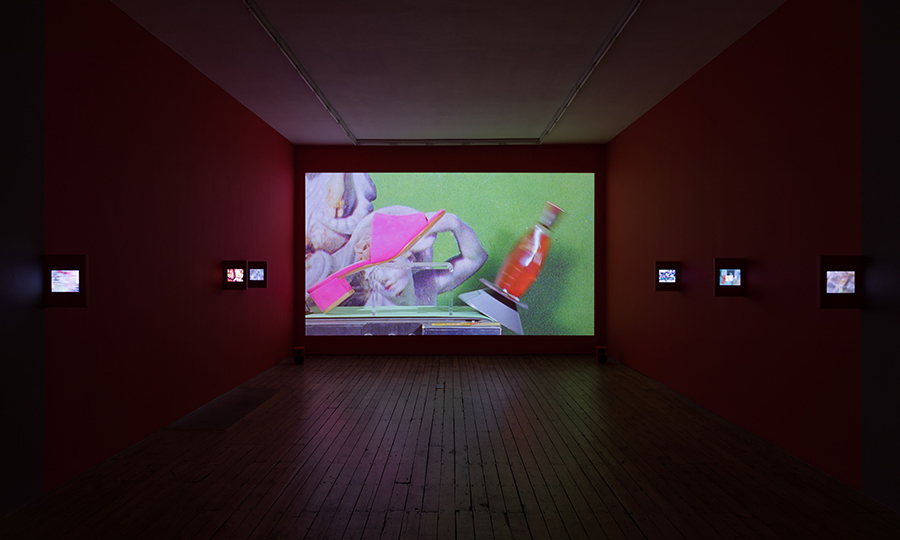The Cognitive Dissonance of Sara Cwynar’s Media Haven
Saturated with marketing sleights of hand and anti-capitalist theory, her work isn’t to blame, any more than I am for reproducing the same rhetoric here
Saturated with marketing sleights of hand and anti-capitalist theory, her work isn’t to blame, any more than I am for reproducing the same rhetoric here

‘What do I need from you in order to complete myself?’ asks a man’s voice. He’s calm and cogent with the authority of a presenter on National Public Radio's This American Life (1995–ongoing). A droning sound pulses beneath his words, sedating me. And, as the silver-tongued narrator delivers his script, dense with allusions to critical theory and cultural references – from the postimpressionist painter Paul Cézanne to philosophers René Descartes and Plato – delicious imagery unfurls: tight shots of red mouths, soft blonde whiskers on an upper lip, jewellery boxes, glossed cars, paint that ripples like chocolate in Lindt adverts.
Screened as part of ‘Marilyn’, Sara Cwynar’s first solo show at The Approach, Red Film (2018) was briefly installed in the gallery before being moved online, following the UK’s coronavirus lockdown. Shot in smudgy 16mm, with abundant footage of limbs and symmetrical faces, Red Film is beautiful. But its formal qualities are not pure aestheticism; rather, they serve to replicate the experience of existing on capitalism’s conveyor-belt, which holds us on an eternal loop of craving and consuming.

Having initially studied and worked as a graphic designer, Cwynar is well-versed in the tropes of advertising, which capitalizes on base desires and insecurities. In order to critique this language, Cwynar appropriates it, saturating Red Film’s imagery with marketing sleights of hand. Elegant fingers direct our gaze, imbuing the objects they touch with allure. This cognitive bias – the belief that an object is desirable because it is associated with something beautiful or good – is known as the halo effect. And, I’ll admit it, Cwynar’s trick works on me: I want that NARS blush compact on the screen. Its image brings back memories of the powdery smell of my mum’s makeup bag and Christmas gifts. Maybe, if I owned it, I would be like the woman holding it: complete. Maybe I would feel as safe and loved as I did in my nostalgic recollections. The narrator’s sermon, the thrum of the music, the revolving objects: this is the insidious trance of advanced capitalism.
In addition to Red Film, six, small silent videos line the gallery walls. They document a range of settings, including an Italian hosiery manufacturer (Pantyhose Factory, Italy, 2020) and a near-empty department store (Barneys New York, 2020). Less engaging than Red Film, these clips nonetheless make a point about the suffocating torrent of images many of us endure daily. In the gallery’s annex is a selection of Cwynar’s photographs. They’re as beautiful and tightly wound with theoretical references as her film, but fail to pack quite the same punch. Perhaps it’s because they’d look so good on a collector’s wall. I’m left thinking about their price point.

But isn’t this precisely the point Cwynar’s trying to make? That this cognitive dissonance exists within us all? That we can nod our heads emphatically when we recognize a reference to a postmodern thinker who slammed the evils of the system, but also feel pacified by a world of luxury? That we can follow an artist calling out consumerism via a blue-chip gallery's online viewing room? ‘You told me you were made up of a thousand ideas of yourself,’ the narrator says. Yet, as theorist Mark Fisher noted in Capitalist Realism: Is There No Alternative? (2009), this performative quashing of capitalism in culture only reinforces it. Media becomes our haven, a safe space where we can flex our critical muscles while absolving ourselves of any guilt surrounding our own inaction. But Cwynar’s not to blame, any more than I am for reproducing the same rhetoric here. Maybe there simply is no alternative.
Main image: Sara Cwynar, 'Marilyn', 2020, exhibition view. Courtesy: the artist and the Approach, London; photograph: Jędrzej Nyka























